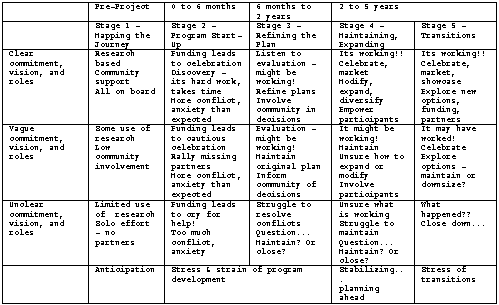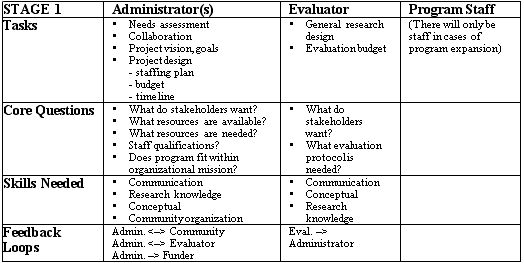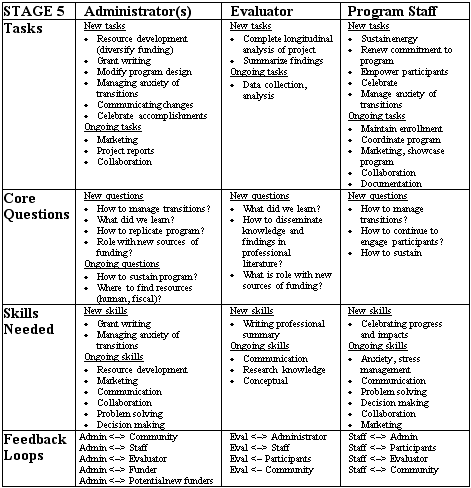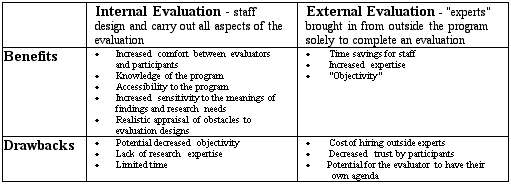October 2001 // Volume 39 // Number 5 // Feature Articles // 5FEA4
Essential Tasks, Skills, and Decisions for Developing Sustainable Community-Based Programs for Children, Youth, and Families at Risk
Abstract
Experienced grant writers suggest the only thing worse than writing a grant proposal is getting funded! For those with little or no experience in program development, the many decisions of running a grant-funded project are both overwhelming and costly. The effectiveness of those decisions ultimately affects a project's sustainability. This article draws on experiences from Cooperative Extensions Children, Youth and Families At Risk (CYFAR) projects in proposing a model for sustainable community-based programs. The model delineates five typical stages of program development, and the critical tasks, skills, core questions, and feedback loops essential at each stage of effective practice.
Introduction
Critical issues of our nation's children, youth, and families are being solved by innovative community leaders able to patch together effective programs from a variety of temporary sources of funding. To survive, these programs must waste no time in maximizing scarce resources and demonstrating intended outcomes.
Getting funded certainly is exciting, but it also anxiety producing. A myriad of actions and decisions are required to answer the question "now what?" For educators and community members with little or no experience in program development for at-risk youth and families, the many decisions can be overwhelming. This is exacerbated when the funding is start-up money with an expectation that the program will be sustainable when the funding period is over.
This article offers a "road map" to enable program administrators, evaluators, and staff to consider and anticipate what is needed for effective evolution of a program. The model examines and elucidates aspects of joint and individual decision-making necessitated at various stages of program development on the "journey" towards sustainability. Tasks, core questions, skills, and feedback loops are delineated at each stage corresponding to a 5-year federal grant for children, youth and families at-risk (CYFAR) program. These stages can be used as a guide for effective practice regardless of the source or duration of initial project funding.
Five-Stage Model of Developing Sustainable Programs
Program development is not neat or orderly, and it does not progress following a straight line. Many variables affect program development, including:
- Knowledge and skills of program administrators, evaluators, and staff
- Level of teamwork and communication between administrators and evaluators
- Relationships among and between community partners
Five common stages of community-based program development include:
- Mapping the journey . . . grant writing and planning
- Taking a test drive . . . program start-up
- Refining the plan
- Exploring new fields . . . program expansion and improvement
- Moving on . . . program transitions and sustainability
As can be seen in Figure 1, where a program is in terms of development is not necessarily connected with the length of time the program has been funded. This model offers program team members a way to:
- Clarify and modify their perceptions of the program's progress
- Analyze the stage of development they believe the program is currently at and where they would like it to be
- Elucidate actions needed to advance the developmental process.
Charting Progress in Community-Based Program Development

In general, perceptions of optimism or pessimism are connected with either high commitment and clear vision and roles, or low commitment and unclear vision and roles. Maintaining realistic optimism is important to encourage effective program development.
Movement towards sustainability demands appropriate decisions be made at each stage of program development. This is a journey for stakeholders, program participants, Cooperative Extension staff, and program staff alike. These decisions require collaborative efforts on the part of each component of a program. Teamwork, particularly between administrators and evaluators, is required in order to supply staff with crucial information and to move the program forward in a meaningful way for the at-risk audience. The community-based program development model (Figures 2-6) outlines the stages and associated tasks, core questions, skills, and feedback loops suggested for all program team members.
Common tasks, core questions, skills, and feedback loops are explicated in the tables, followed by descriptions of program development stages with associated examples for administrators and evaluators in each stage.
Definitions: Tasks, Core Questions, Skills, and Feedback Loops
Each of the five stages of typical program development has specific actions, techniques, and communication demands for administrators, evaluators, and staff to grapple with in order to effectuate program development in a manner conducive towards sustainability.
Tasks
Tasks include what is expected of each actor dependent on their role in the grant in order to move development of the program forward. Delineation of tasks assists actors in maintaining clarity of function and accountability to other members of the team.
Core Questions
The core questions outline detailed issues each actor needs to resolve in order to remain within the confines of his or her role and stay on track. There are both practical and ethical questions to consider in effective program development. Practical questions entail examining what is possible at that moment based on resources, knowledge, and information that is available at that moment in time. Ethical questions involve appraising what is right based on values, principles, and standards.
Skills
Skills are the techniques and know-how each actor either needs or has to acquire for a program to effectively move towards sustainability. Strong skills will assist with dealing with both the excitement of program development (which can over-ride careful planning) and anxiety (which can prevent actions).
Feedback Loops
Feedback loops are the communications needed between and among actors in order to maximize collaboration and empower communities and participants. Feedback loops at the beginning of program development are fairly simple, but they become more extensive and intricate at later stages of development. The importance of clear communication becomes evident when the feedback loops are contemplated. Without clear communication, information can be lost, misinterpreted, or distorted.
Stages of Program Development
Stage 1: Mapping the Journey . . . Grant Writing and Planning
Any journey requires good planning, competent and pertinent research, and a commitment by program constituents to continue the endeavor. Good planning necessitates using information and data gathered before program inception (Johnson, Willeke, & Steiner, 1998) and research undertaken after program initiation (Allen & Paisley, 1998). This planning is analogized to pre-journey contemplation with decisions to be made regarding the type of services to be offered, examination of resources available, and the outcomes or goals desired as a result of the program's services.
Tasks, Core Questions, Skills, Feedback Loops Common in Stage 1

Involvement of stakeholders is a critical responsibility of program administrators. Goals constructed with all stakeholders are one part of this stage of the program development journey, although this is insufficient to determine success (Verschuren & Zsolnai, 1998). What the stakeholders want, however, remains an essential question to consider at each stage if there is to be true collaboration and movement towards sustainability (e.g., the program being "anchored" in the community). Stakeholders who participated in the needs assessment may not be the stakeholders who will ultimately sustain the program, so eliciting on-going feedback and keeping lines of communication open is indicated to advance collaboration.
Evaluators at this stage need to focus on how evaluative efforts can assist with the on-going feedback efforts. Additionally, evaluators have to decide who will be evaluated and how the evaluation will occur. Dealing with the practicalities of informed consent becomes an essential task to complete particularly if dealing with Institutional Review Board requirements.
Stage 2: Taking a Test Drive . . . Program Start-Up
Subsequent to the planning stage is the initiation of program activities for participants. At this stage, different elements of programs that may not have been considered become apparent. Continued deepening of collaboration between and among stakeholders and program administration is needed at this point.
Decisions regarding how the program will be managed and how it will be evaluated are major challenges for administrators at this stage of development (Jerrell & Jerrell, 1985). Two broadly defined ways of approaching program development are depicted in the literature (Drummond, 1998; Secret, Jordan, & Ford, 1999).
The first might be thought of as a "package plan" in which a prototypical program with various service components is installed into a community. The community stakeholders may have developed a sense of what is needed, and administrators in this approach will install a program they may have developed elsewhere that appears to fit the needs expressed.
The other approach might be described as a "customized tour" in which the community stakeholders are the guiding force in determining the program offerings. The approach is obviously preferred when striving for true collaboration. Using this approach, however, both administrators and evaluators have to grapple with issues during the beginning stages of program development. Dealing with staff frustration and anxiety when there may be an understandable desire to be told what to do is an issue for administrators.
An associated issue for both administrators and evaluators is deciding what should be shared and when it should be shared. In order to encourage true collaboration, there may be a period of uncertainty and flux before a direction is chosen by stakeholders in conjunction with staff. During this time, general information is useful, but the actual goals, objectives, and service offerings should be decided on by stakeholders and staff. Evaluators in particular may need to steer clear of taking on the task of designing and authoring goals and objectives. Training may be needed to help stakeholders and staff understand what good goals and objectives are and how to construct them in order to measure outcomes.
Tasks, Core Questions, Skills, Feedback Loops Common in Stage 2

Stage 3: Refining the Plan
The next phase of the journey involves using feedback and evaluation to determine how and if the program is moving in the direction of initial goals. Decisions involved in this stage of program development entail what data should be shared with each of the stakeholders. Although empowerment principles propose that collaboration in all phases of evaluation be adhered to (Secret, Jordan, & Ford, 1999), evaluators are still faced with ethical decisions such as those involving issues of confidentiality and role confusion (Hammond, 1998).
For administrators and evaluators, a series of new tasks emerges involving what can be termed the "3R's": review, refine, and renew. All members of the team need to review what has worked, what needs modification, what needs expansion, what budgetary issues have surfaced, and what the findings from evaluation data indicate. Also, members of the program development team need to work on refining goals (with staff and stakeholders), objectives, the program design, and the research design. Renewal of contracts and approval of the evaluation design should be attended to as the last of these tasks.
Tasks, Core Questions, Skills, Feedback Loops Common in Stage 3

Stage 4: Exploring New Fields . . . Program Expansion and Improvements
Refining the program offerings is the next phase of the journey. As noted on the program development chart, this stage can occur anywhere between 2 and 5 years post-funding. When this stage occurs is dependent on variables listed in the chart, specifically, program leadership, commitment of staff, stakeholders desires, and good utilization of resources.
The refinements are the outgrowth of reflections on the first evaluation reports and on-going discussions with all stakeholders. Details to be considered from these consultations include:
- Best practices to explore
- Hazards to circumvent
- Timing issues in thinking about secondary outcomes
- What to do about potential breakdowns (e.g., staffing, finance, or unforeseen problems)
- Creation of contemplation, renewal, and planning time (e.g., conferences and workshops)
The role of evaluation findings is crucial in making decisions regarding whether and how to expand the program and ways to improve the services offered.
Tasks for administrators in this stage include expanding collaboration in the community, continual exploration of alternate funding sources, and marketing of the program. As noted in the chart, administrators may need to expand their repertoire of skills in order to complete these tasks. For example, expansion of collaboration in the community necessitates community organization and communication skills. Additionally, marketing may require broadened knowledge of how to use the media effectively.
Evaluator tasks focus on developing the capacity for programs to be self-evaluating. Because many community programs may not have the know-how to design and complete evaluations, training is indicated for staff so that this capacity can be developed. All stakeholders need to be engaged in this endeavor which also enlarges the collaborative enterprise.
Tasks, Core Questions, Skills, Feedback Loops Common in Stage 4

Stage 5: Moving On . . . Program Transitions and Sustainability
The final stage of the journey towards sustainability entails returning to the pre-contemplation phase to explore the next program to be offered. In all of these steps, good teamwork allows all members of the team to remain on course and get needed support in facing the challenges of planning and executing a program for at-risk families and youth. This stage involves decisions as to whether the program should be expanded or maintained in its current state.
Questions of quality versus quantity may emerge in thinking about expansion. There may also be a question of whether the program should be continued. If the program has not been anchored in the community and additional funding secured, plans for terminating the program need to be put into place. In this case, administrators need to help staff deal with the feelings of letdown that will surface and facilitate debriefings in order to learn from mistakes.
Tasks, Core Questions, Skills, Feedback Loops Common in Stage 5

As noted, administrative tasks include resource development, promoting program modifications, managing staff anxiety, and planning celebrations. Anxiety at this point is to be expected because launching into new funding configurations will require modifications in budgets, staffing patterns, and accountability mechanisms. Regardless of the degree of anxiety, however, staff and stakeholders need to acknowledge their accomplishments through celebrations.
Evaluator tasks revolve around final data analysis to see what was learned and facilitating decision making regarding the model of evaluation to be used in the future. The models of evaluation to be considered are internal or external evaluation. Administrators, staff, and stakeholders can be helped to think about the benefits and drawbacks for each of these evaluation models in order to make an informed choice (Figure 7).
Benefits and Drawbacks of Internal and External Evaluation

Conclusion
Program development, although not a neat and orderly process, has stages that can be anticipated and strived for through good planning and analysis. The model of program development outlined in this article proposes a series of stages with associated actions, skills, and core questions that can assist administrators, evaluators, and staff in the decisions to be made at each juncture.
This model is based on both the literature and the experiences of four of the University of New Hampshire Cooperative Extension's Youth At Risk (1991-1996) and State Strengthening projects (1998-2003). Careful and early planning, and decisions and task management linked to clear commitment, vision, and roles helped chart a course of early sustainability and program expansion in two of New Hampshire's four grand funded community-based projects. The remaining two projects are progressing through the third and fourth stages of program development. Although this model has not been extensively tested, educators at the annual Children, Youth and Families At-Risk (CYFAR 2000) conference have attested to the practicality and soundness of the model.
References
Allen, L., & Paisley, K. (1998). The top 10 ways to impact at-risk youth in recreation. Parks & Recreation, 33(3), 80-86.
Drummond, J. (1998). Some challenges to be faced when building capacity. Clinical Nursing Research, 7(4), 331-335.
Hammond, O. (1998). Ethical considerations in program evaluation. In Anderson, R., & Needels, T. (Eds.), Avoiding ethical misconduct in psychology specialty areas. Springfield, IL: Charles C. Thomas Publisher.
Jerrell, S., & Jerrell, M. (1985). Road signs in ethical quicksand. Evaluation and Program Planning, 8(1), 73-76.
Johnson, R., Willeke, M., & Steiner, D. (1998). Stakeholder collaboration in the design and implementation of a family literacy portfolio assessment. American Journal of Evaluation, 19(3), 339-364.
Secret, M., Jordan, A., & Ford, J. (1999). Empowerment evaluation as a social work strategy. Health & Social Work, 24(2), 120-128.
Verschuren, P., & Zsolnai, L. (1998). Norms, goals, and stakeholders in program evaluation. Human Systems Management, 17(2), 155-162.
